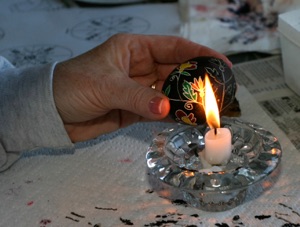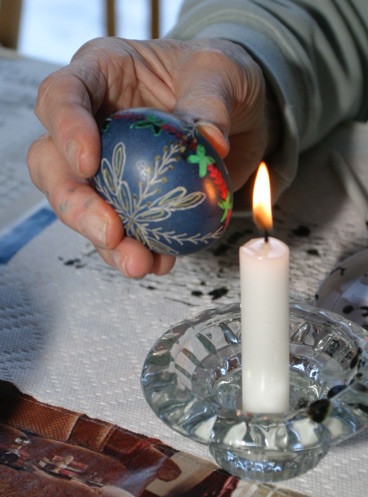Wax Removal
Candle Method
Wax Removal
Candle Method

This is the method you see described most often in books about pysankarstvo, depicted on websites and in videos, and demonstrated in classes. It was not a method in common use in Ukraine in the old days, but one that became popular in the diaspora and has become common in modern times.
Removing Wax: To remove wax from a pysanka with a candle, start with a dry, waxed egg. Before proceeding, inspect it carefully for any cracks. If the shell has become cracked during the pysanka writing process, removing the wax with heat may cause the egg to break or burst. If you find any cracks, use another method.
If you are using an emptied egg, MAKE SURE that the drain hole is open–no wax plug or membranes blocking it.
Grasping the egg firmly with one hand, hold it next to (but not in) your candle’s flame. Be careful to keep your fingers–and thumb– well away from the flame.
If you have acrylic nails, or long fingernails with nail polish on them, be very careful when working near an open flame. It is quite possible–and easy– to set your nails on fire, particularly the thumb. Do not let your nails get too close to the flame!
If you have long hair, and especially long bangs, tie it back when working with candles. Hair can easily fall into the candle flame and go up in a puff of smoke!
DO NOT hold the egg over the flame, because soot will deposit on the eggshell, or you may even scorch the shell itself.

The CORRECT way to hold an egg:
alongside the flame, and not directly in it

The WRONG way to hold an egg:
over the flame and in the flame.
You can see the soot deposition on the shell.
Allow the wax to melt fully in one spot; wait until the wax looks wet (this usually takes only a few seconds) and wipe the wax off with a clean, folded piece of paper towel. Try to always use a fresh section of the towel (or a new towel) for each wipe, or else you'll just be rubbing wax all over the egg, and it will take a lot longer to finish your egg.


Heat the egg..............................................................and then wipe off the wax
Repeat this, a section at a time, until all of the wax has been removed. If there are any small smudges of wax remaining, you can choose to remove them with Mineral Spirits or Goo Gone.

WARNING: It is important to bear in mind that the contents of the egg, the white and the yolk, act like a heat sink. When you heat a full egg, the heat is dissipated over the entire egg. When you work with emptied eggshells, this does not happen. Instead, the entire shell heats up quite quickly and, if you’re not careful, you could burn your fingers. With empty eggs you may need to clean a bit of the egg, set it aside to let it cool off, and then clean a bit more.
The candles in the photos above are paraffin candles; while these give a reasonably good result, you can get much better results using beeswax candles. Beeswax candles produce much less smoke, and thus much less soot. Even the most careful pysankarka can get some soot deposition, so minimizing the risk is a good idea.
New beeswax candles can be expensive. I use beeswax candle stubs, which I get free from my church. This is an option worth looking into. Even a beeswax-paraffin mix candle is better than a pure paraffin one.

Once you’ve removed all of the visible wax, small amounts of soot and beeswax may remain. To remove the soot, see the problem section below. Remove residual beeswax, see that section here.
PROBLEMS: The two main problems with this method are the possibilities of soot deposition (remediable) and scorching (not remediable).
What is SOOT? Sometimes the fuel (candle wax) molecules don’t burn up completely. They clump together to form particles called soot, which can deposited on the surface of your egg.
SOLUTIONS: How do you get rid of it? If there is a lot, is might be worthwhile to drip some candle wax (using the stylus or the candle itself) onto this area. Let it cool, and then just heat and rub with the paper towel as you did before. The soot particles will dissolve in the wax and be removed when you remove the wax. You may have to repeat this a few times if there is a lot of soot.
Solvents will help, too, but, in my experience, they are better used for small amounts of residual soot rather than large depositions.
For more detailed discussion and instructions, go to this page.
What is SCORCHING? Scorching occurs when you hold the egg too close to the flame and actually burn the cuticle. The cuticle is made of protein and, like other proteins (hair, wool) will burn when heated too much. The black or brown areas of scorching are charred/burned egg, not merely some foreign substance deposited on the egg.
SOLUTIONS: There are none. Once the damage is done, it is done. Avoidance is the only successful strategy.

DO NOT do this!!!!
Back to Main Wax Removal page
Back to Main Pysankarstvo page
Search my site with Google
Removing the Wax with a Candle

